![]()
| Guizhou, China | Southeastern Guizhou | 2002.06.11 - 06.20 |
Minorities
South of Kaili, in the southeastern most corner of Guizhou Province is a 400 sq. km area of Miao and Dong minority villages. Remembering our superb experiences in the minority areas of southern Yunnan Province, we were enthusiastic to see more minorities in colorful traditional costume.
Travel throughout Southeastern Guizhou is by bus along winding bumpy dirt roads. Rains cause mudslides and minor flooding, making some roads temporarily impassible. Nevertheless, with time and patience, travel through this region can be rewarding. We, however, still preferred Yuanyang, Yunnan for the scenery and greater diversity of minorities.
The Miao costume is more colorful than the Dong. On market days, Miao women wear their best clothes, dangling heavy silver necklaces. North of Congjiang is predominantly Miao. South of Congjiang is nearly 100% Dong.
FACILITIES
Southeastern Guizhou, south of Kaili, is one of the poorest areas in China.
Larger towns restrict tourists to more expensive tourist designated hotels.
Smaller towns have no accommodation. Restaurants are decent and cheap. We
generally paid less than ¥5 per person per meal. Banks are sporadic and
ATMs don't exist. Internet doesn't exist, even in the larger towns. The only
exception is in Zhaoxing where a slow dial-up connection costs ¥10
per hour, 5 times more than in Kaili or Sanjiang for a high speed ADSL line.
Buses run regularly, but generally only during the morning. Roads are rough
but the surrounding scenic beauty provides enough distraction from the
bus ride. Every village is infested with blood-sucking flies, mosquitoes and
other annoying insects. Carry repellant.
XIAJIANG
The most colorful market we saw was in Xiajiang, halfway between Rongjiang and
Congjiang. Xiajiang's market is once every 5 days. Hotels in Rongjiang and
Congjiang know the dates. Xiajiang Market was a mix of thousands of Miao and
Dong in traditional costume. Unfortunately, there's no accommodation in town.
By bus, it's 1.5 hours from Rongjiang or 2 hours from Congjiang although the
distances on a map make it deceptively appear closer to Congjiang
GAOZENG
An interesting Dong village 7km east of Congjiang is Gaozeng. Dong drum towers
rise above the village houses, and a pretty covered bridge shelters pipe
smoking old men lounging the day away. Motorcycles from the Congjiang bus
station charge ¥2 per person to the Gaozeng junction, 2.5km from the
village. The 2.5km is a pleasant walk on paved road past smaller Dong villages,
also with drum towers. The other transport option to Gaozeng is by trishaw.
They'll charge ¥20 for 2 people if you're lucky. To get there on foot
from the Congjiang bus station, walk towards the nearby roundabout and
continue along the same side of the river. Turn right at the first road (about
1km distant). This road looks like a cross between a mudslide and a construction
zone. After a rain, it's also a deep mud puddle. The Gaozeng turnoff at
5km distance is very obvious with a distance sign in both Chinese and English.
ZHAOXING
Continuing further east from Congjiang is Zhaoxing, the prettiest Dong village we
saw. Zhaoxing boasts 5 drum towers, at least 3 covered bridges, and has beautiful
walks in every direction for hours on end. Although remote, Zhaoxing has a fair
number of foreign tourists, probably due to Lonely Planet. Lonely Planet says in
Zhaoxing, "the surrounding countryside may be the most beautiful you ever see."
This statement is a gross exaggeration, and it attracts people of many nationalities
with high expectations. Most people stay in Zhaoxing for a night or two, which
is sufficient to see the entire town and some of the surroundings on foot.
TANG'AN
After two nights in Zhaoxing, we waited for the once-daily bus to Sanjiang in
Guangxi Province. Since this bus originates in Liping, about 3 hours north, it
tends to cross through Zhaoxing between 09:30 and 10:00. We waited and waited.
At noon, our guesthouse owner was surprised to see us. Calling the Liping bus
station, he discovered the bus broke down. Feeling sorry for us, he guided us
on a 4-hour walk to Tang'an Village that afternoon. Tang'an has a relaxing
atmosphere with a marvelous water system. Potable water from a mountain spring
empties into a continuously running fountain with wooden drinking ladles. One
level below is a tub for washing vegetables. Lower down, the flowing water is
used for bathing. Finally, the lowest end is for clothes washing. The patter
of running water, the refreshing breeze over the hilltops, and the clean
stone sitting areas make Tang'an an excellent visit.
| Dong people at the Congjiang Market. | ||
 |
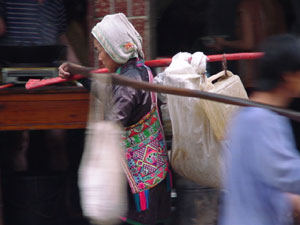 |
 |
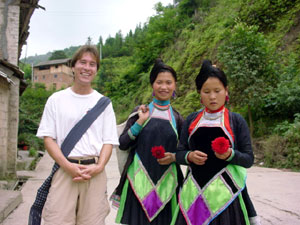 |
Wes asks to have his photo taken with two Miao girls near the town of Congjiang. Their village is a 7km walk through the rice paddies from the main road with public transportation. |
 |
Miao woman at the Xiajiang Market dress to the hilt with heavy silver necklaces. |
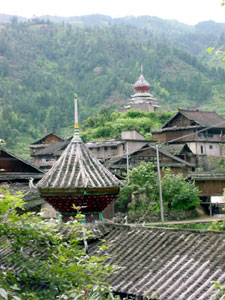 |
Gaozeng town is 7km east of Congjiang. It's a small version of Zhaoxing and good for a relaxing 1 hour stroll. |
 |
The covered bridge in Gaozeng has three temple tops and a hand-painted ceiling. Old men smoking pipes lounge away the day on this bridge. |
 |
The town of Zhaoxing boasts 5 Dong drum towers, several covered bridges, and a traditional village. It's probably the prettiest Dong village in the area. |
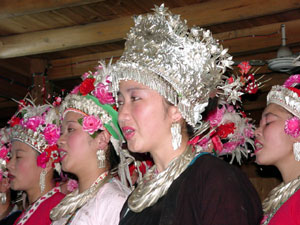 |
Our first night in Zhaoxing was a lucky night. 3 Swiss tour agents on a business trip to collect travel information stayed at our guesthouse. The local tour operator requested a dance by the local Dong people. They dressed in colorful ceremonial costume and performed for about 2 hours. |
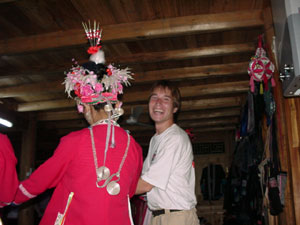 |
Wes tries to follow the lead of Dong dancers and dances (rather badly) in a ring. |
 |
Two Dong girls marvel at the display on our digital camera and ask for their photo to be taken. |
 |
A woman prepares indigo for cloth dying in Zhaoxing Village. |
 |
A satellite dish sticks out of a hole in the roof of this dilapidated house. Every village in China, no matter how poor has satellite TV. They are only allowed to receive Chinese transmissions, however. |
 |
Kids play on a parked Chinese tractor in Tang'an Village. |
Copyright © 2000-2002 Wes and Masami Heiser. All rights reserved.